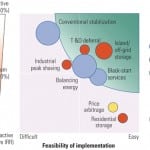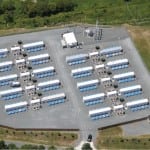The next decade could belong to energy storage. Project development costs are dropping. Enhanced state and corporate focus on climate-related issues is producing more opportunities for renewable generation and for firming renewable intermittency through energy storage.
COMMENTARY
The ability to apply non-recourse financing to energy storage projects at the company level is following the growth of off-take and market opportunities. From an engineering perspective, energy storage could represent the pinnacle of multi-dimensional solutions to complex generation, transmission, and distribution problems for integrated resource planning and organized market design, because energy storage resources can shift between serving generation, and transmission and distribution roles, on the bulk power system.
The technology’s versatility, however, has produced a regulatory conundrum that forces energy storage projects to search for a raison d’etre. Project developers must consider an existential question—Are they generation? Transmission? Distribution? The answer is critical because current guidance on cost recovery from the Federal Energy Regulatory Commission (FERC), state regulatory commissions, and regional transmission organizations (RTOs) arguably prevents storage projects from serving multiple roles.

This problem exists despite extensive efforts to promote the full potential of energy storage technology. Stakeholders have filed thousands of comments to FERC, to state regulators, and to RTOs, advocating collaboration and innovation to allow energy storage to reach its operational potential, including serving multiple roles on a power system. An important part of these discussions is cost recovery.

In response to stakeholders, regulating entities have been cautious about establishing consistent, industry-wide rules on cost recovery for energy storage dispatched interchangeably as a generation-transmission or generation-distribution asset. To be fair, regulatory entities must establish market structures that produce just and reasonable wholesale and retail power rates. In the multi-use energy storage projects reviewed by FERC to date, payments for transmission and distribution have been on a cost-of-service basis, and payments for market services are based on market rates.
It is difficult to reconcile two cost-recovery mechanisms for the same asset providing different services to the grid. Regulators and organized markets cannot allow developers to “double dip,” that is, to recover twice for the same capacity and operating costs. Regulators and organized markets also cannot allow storage projects to use their cost-of-service rate revenues to subsidize “low ball” bids for sales of capacity and energy in competitive markets.

FERC, therefore, has proposed crediting revenues received from the sales of market services against cost-of-service revenue requirements received for transmission service. Additionally, FERC has required market participants to demonstrate their ability to recover costs under a cost-of-service tariff that does not create an unfair subsidy when making market sales. It’s helpful guidance, but FERC has created a “chicken-and-the-egg” issue. FERC generally will not review a petition seeking guidance on cost recovery unless an energy storage project is sufficiently advanced through development, but a project will not progress through early-stage development unless it has certainty of cost recovery.
What are storage developers to do? Rely on revenue use cases based solely on a transmission or a generation role, ignoring the versatility of the resource? The current regulatory environment probably requires this choice for many projects.
For storage as transmission/distribution (T/D), this means presenting a cost-effective alternative to a T/D upgrade and competing for congestion relief projects in RTOs. Deploying an energy storage resource for congestion relief means congestion relief must take priority over market service dispatch, even when the market service is potentially more lucrative. The obligation to prioritize congestion relief when serving a T/D function could inject enough uncertainty into a revenue stream to complicate project financing. Conversely, the developer can go the generation route and dispatch into a particular wholesale or retail market, forgoing transmission or distribution revenue—which could leave congestion unmitigated in the most cost-effective manner.
Without more reliable guidance from FERC, RTOs and states likely will need to lead the discussion on how best to use energy storage. Midcontinent Independent System Operator (MISO), for example, has instituted stakeholder processes to evaluate how energy storage projects should be included in transmission planning versus as a resource applying for generation interconnection. In December 2019, MISO filed a “storage as transmission-only asset” proposal at FERC, establishing a framework for storage to be evaluated on a comparable basis with transmission investment in the MISO transmission planning process, though it would restrict selected storage assets to a transmission-only role. This restriction ultimately must be reconciled with MISO’s distributed energy and storage-related compliance obligations, which require storage to be able to participate in MISO markets. The December filing explains that MISO is working with stakeholders to develop a process allowing energy storage to shift roles.
Whether led by FERC, RTOs, or states, establishing mechanisms that balance efficient market interests while ensuring adequate access for energy storage resources to serve roles in generation, transmission, and distribution is the difference between fulfilling and squandering the potential of energy storage resources. Energy storage will have a place in organized markets and state resource plans over the next decade, but its importance is dependent on several factors, including cost recovery. The hard reality is that the current regulatory environment limits energy storage’s potential.■
—Joe Hall is partner, Kyle Wamstad is counsel, and Dan Nugent is associate at Eversheds Sutherland.










